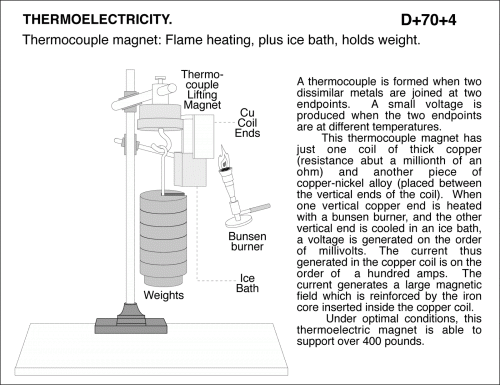Thermocouple magnet: Flame with ice bath, holds weight.
Primary tabs
Thermocouple magnet: Flame with ice bath, holds weight. A thermocouple is formed when two dissimilar metals are joined at two endpoints. A small voltage is produced when the two endpoints are at different temperatures. This thermocouple magnet has just one coil of thick copper (resistance abut a millionth of an ohm) and another piece of copper-nickel alloy (placed between the vertical ends of the coil). When one vertical copper end is heated with a bunsen burner, and the other vertical end is cooled in an ice bath, a voltage is generated on the order of millivolts. The current thus generated in the copper coil is on the order of a hundred amps. The current generates a large magnetic field which is reinforced by the iron core inserted inside the copper coil. Under optimal conditions, this thermoelectric magnet is able to support over 400 pounds. See D+70+8 for more info on the Peltier Device. The Peltier device consists of a series of tiny thermoelectric cells made of P and N doped silicon semiconductor material. Heat entering the cell raises the energy level of some of the electrons, freeing them to migrate through the N material. Holes can migrate through the P material. The electrons flow from the N material through the external circuit and drive the fan motor, then recombine with the holes in the P material. As long as there is a sufficient temperature differential (50 deg C) between the two sides of the cell, the fan turns. Cold water in the left cup and hot water in the right cup makes the fan rotate counter-clockwise. Hot water in the left cup and cold water in the right cup makes the fan turn clockwise. Boiling water and iced water (or dry ice) give best results.
UCB Index:
D+70+4
PIRA Index:
5E50.30
UCB Taxonomy:
PIRA Taxonomy:
Popularity:
- Log in to post comments

